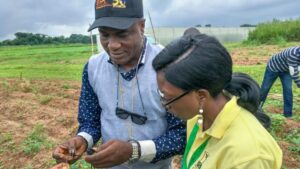Borlaug Scholar Alex Ogbonna is a Ph.D candidate working in the Lab of Professor Lukas Mueller at Cornell University. Upon completing a B.S. in Chemistry and M.S. in Analytical Chemistry from Imo State University and Michael Okpara University of Agriculture respectively, he worked with a cassava molecular breeding team at National Root Crops Research Institute in Nigeria. Alex later moved to Boyce Thompson Institute as a crop database developer. There he developed database tools to assist breeders of cassava, banana, yam, sweet potato, maize, and solanaceous crops. His desire to effectively communicate with breeders led him to the Cornell Plant Breeding and Genetics graduate program. Alex’s current research is focused on the impact of modern breeding on the evolution of key trait architecture through domestication and its implication for cassava breeding.
He sits down with Seed World to tell us his story.
I grew up eating cassava. Learning about it and its potential impacts from the perspective of food insecurity (especially on smallholder farmers), climate change and the global economy, has kept me working with cassava. My fascination with cassava, has to do with how resilient it is to drought.
As a PhD student, my research interest has been to leverage genomics for the purpose of expanding insights on domestication and diversification with the objective of improving crop adaptation in cassava. Cassava is an important economic and subsistence starchy root crop and produces maximally under sub-optimal conditions. It is no surprise that cassava is the sixth-ranked most important source of calories in the human diet. However, yield is still sub-optimal in most regions where cassava is grown, especially in sub-Saharan Africa.
Cassava was reported to have originated and been domesticated in Brazil (over 6,000 years ago), and was later introduced to Africa (over 500 years ago). It went through additional improvement in Africa to combat disease resistance and improve yield. While the improvement brought about resistant and high yielding varieties, there were key trait architecture deviations, resulting in traits usually part of a primary breeding objective showing negative genetic correlation in African populations, while maintaining its positive correlations in Latin American populations.
Other traits such as root cyanide were inconsistently characterized in African populations, which has been attributed to inconsistent transfer of ethnobotanical knowledge surrounding use-category management from South America to Africa.
To provide insights into these highlighted challenges associated with cassava in Africa, my PhD studies were focused on understanding “The impact of modern breeding on key traits architecture evolution through domestication and its implication for the cassava breeding approach.” And so, the premise of my studies was framed around understanding what has happened in African germplasm from the perspective of the Brazilian.
My personal life, professional experience and motivation for studying plant breeding all originated from the same place: a rural area in Nigeria called Suleja. In my earliest childhood memories, I remember my mum waking up at dusk, cooking and preparing cassava early in the morning for our meals.
From a farming background, I always had a strong interest in agriculture in general and plants in particular. Studying plant breeding provided me the opportunity to develop a skill set within a scientific field of interest, and was the culmination of my personal background and doing research for agricultural purposes.
Given that I grew up on the farm, I never thought agriculture was something I could study during my time as an undergrad. Working with the cassava molecular breeding team after my undergrad, under the supervision of Dr. Emmanuel Okogbenin, brought back my childhood memories. However, no Nigerian university would allow me do a direct MSc. program in plant breeding. When I got the opportunity to join Professor Lukas Mueller’s Lab., and worked with the crop database development team, my previous interest in breeding, desire to effectively communicate with breeders and passion to develop tools that can be utilized for routine breeding activities, led me to Plant Breeding and Genetics graduate program at Cornell University.
The crop databases developed and maintained at MuellerLab, are web-based “Digital Ecosystems” that serve as a central platforms with integrated breeding workflow for modern breeding purposes. These databases started as Cassavabase and expanded into dozens of different crops. It is now called Breedbase and available on GitHub as open source software, packaged into a Docker image for deployment.
Modern breeding methods are data-centric and data management has become a priority, highlighting the need of a database at the center of breeding processes. Looking at crop databases from the perspective of research projects, these projects are now expanded with multiple components, requiring different expertise and multiple breeding centers. Crop databases should have the capacity to connect these breeding centers and standardize measurement procedures, thereby enabling decision making and exchange of information within a fully integrated system. From a personal point of view, my interest in developing crop databases has to do with the two major roles they play: automating breeding processes and improving the efficiency of a breeding program.
Some of the recent achievements in the area of crop database development, includes developing them into a dynamic crop-agnostic fully integrated systems, figuring out large and multi-layered high-dimensional dataset storage structures that allow for easy and fast retrieval, while maintaining their relationship with other datatypes (phenomics and genomics) within the database.
These multi-layered high-dimensional datasets include transcriptomics, metabolomics, image high-throughput phenotypes, near infrared spectroscopy (NIRS), ground penetrating radar (GPR) phenotypes, and other data-types from recent novel phenotyping methods. Advances have also been made in a breeding application interface (BrAPI), that allows for exchange of dataset objects across different breeding platforms/databases.













